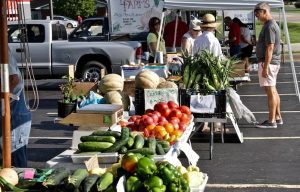This year’s corn harvest among best ever
By ALAN DOOLEY
Following on the heels of a great wheat harvest this past spring, positive results are coming in for this year’s corn crop in Monroe County.
Some are saying this year’s crop is above average, with others calling it one of the best ever.
“This is the best I’ve ever seen,” Delbert Wittenauer said of his fields’ yields.
Wittenauer said 130 bushels per acre is a mark of success in some years. This year, he is seeing 150 to 200 bushels per acre on the high ground and 225 to 275 bushels per acre in the bottoms. With computer measurement capabilities in high tech combines, he said it is possible to spot yields of up to 320 bushels per acre in some areas of a field.
Whichever numbers you accept, indications are that record corn harvests are in store for 2014.
Another area farmer, Glen Mueller, said he was very pleased with the corn yield this year. Mueller, who farms some 500 acres in the bottoms and 1,100 acres in the hills, said that while yields are up, prices are down – so the end “pay day” may be about the same this year as last.
Don Schrader called the corn harvest excellent.
“This is the best corn harvest I’ve seen since I started farming in the 1970s,” he said.
He, too, noted however that lower prices are balancing high yields this year.
Prices change based on a number of factors, including crop quantities harvested, their
quality, and demands for animal feeds and human consumption, as well as for ethanol production. And, of course, exports overseas to feed a growing global population are large factors.
Where crops go
The bumper crops are being harvested by farmers, but that is just an initial step as they head to market. They impact other businesses as well.
One such business is the Gateway FS barge loading facility at Kemper’s Landing on the Mississippi River near Fults. There, the Republic-Times watched a barge being loaded with corn for its journey down the Mississippi River to the Port of New Orleans, where it will join hundreds of other barge loads as part of an estimated 60 million tons of grain exported overseas.
Kemper’s Landing manager Randy Braun told how barges are delivered there by small tow boats that are the river equivalent of switch engines. They are tied to pilings there, and a cable and winch system moves the barges slowly as corn is loaded via conveyer system from the facility’s giant storage bins.
Braun said it takes several hours to load a barge. Up to two such evolutions may be carried out in one day during the peak harvest season.
“That’s when days get to 12 or more hours,” he said.
Shipping bulk agricultural goods like grain by barges is cost efficient. While an 18-wheeler carries 25 tons, and a large railcar some 100 tons, a barge carries as much as 1,600 tons. And barge movement uses much less fuel than road or rail transport.
A University of Iowa report indicates barges can move a ton of grain 500 miles on a gallon of fuel. Trucks carry a ton about 60 miles and trains 200 to 300 miles on that same gallon of fuel.
Barges loaded at Kemper’s Landing will be linked together and sent south to New Orleans, pushed by a large tow boat.
“I’ve seen barge tows measuring seven barges wide and seven long,” Braun said.
That’s close to 80,000 tons of cargo being moved by one small but highly trained crew. Some 60 million tons of grain travel down the Mississippi River to export depots in New Orleans every year.
While the Republic-Times was visiting Kemper’s Landing, an 18-wheeler arrived every few minutes, discharging its cargo into underground hoppers from which it is moved by conveyers to large storage bins that can hold up to 500,000 bushels.
Braun said it is normal to receive 50 to 60 trucks a day during harvest season.
Future crops
Farming is an endless cycle of planning, planting, nurturing and harvesting. One element that few non-farmers consider, is the ongoing work to zero in on the best seeds for next year’s crops. The goal is to develop and provide farmers with the best seed stock to deliver higher yields from the same acreage to feed the world.
Test plots, found throughout the region, are used by grain seed providers to compare past seed stocks with newly developed varieties that may enable farmers to increase yields on the same acreage.
One such plot is on Schrader’s farm on Kaskaskia Road, where corn is grown for scientific analysis of results. Schrader has participated in this work for many years, he said.
On Friday, Gateway FS agricultural experts harvested that field to accurately measure the performance of several varieties of corn seed.
Each variety is planted in six row strips, according to Gateway FS crop specialist Gary Brandt. In the fall, each strip is harvested separately by a carefully controlled combine and samples are examined to determine how each variety performed. Varieties that performed best in this area will be identified and offered to farmers for next year.
Next up for harvest are soybeans, which promise to do quite well this year as well.








